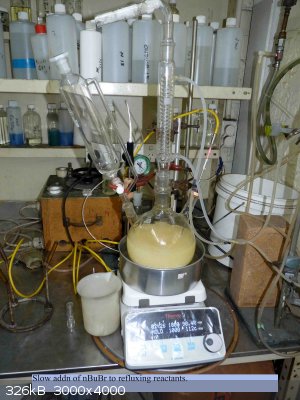FrankMartin
Hazard to Self
 
Posts: 50
Registered: 30-5-2010
Member Is Offline
Mood: No Mood
|
|
Malonic Ester Synthesis. Side reactions
Hi, an experiment with the malonic acid synthesis gave a poor yield and much low-BP product. (ME = "malonic ester")
ME + RBr + NaOEt = R-ME(desired product)+ NaBr
But the following seems to occur too.....
ME + RBr + NaOEt = ROEt (an ether) + R-ME + NaBr
What are the best reaction conditions to maximize the first equation?
Frank
|
|
|
TheRealKP
Harmless

Posts: 4
Registered: 27-4-2018
Member Is Offline
Mood: No Mood
|
|
FrankMartin,
You should add the sodium ethoxide solution slowly with a pressure-equalized addition funnel, and keep the reaction concentration low. Whatever else
you do depends upon the R group that you are using. Basically then it comes down to a kinetic versus thermodynamic approach.
I was trained in a lab with students who worked on exactly the same reaction and they seemed to have succeeded in obtaining the ME-R species.
KP
|
|
|
aga
Forum Drunkard
    
Posts: 7030
Registered: 25-3-2014
Member Is Offline
|
|
Welcome to ScienceMadness TheRealKP !
I see you went to the trouble of joining two months ago, yet this is the first post.
There is no need to be shy here.
|
|
|
Sigmatropic
Hazard to Others
  
Posts: 307
Registered: 29-1-2017
Member Is Offline
Mood: No Mood
|
|
The best conditions to maximize the first reaction is to completely suppress the second reaction by using a non nucleophilic base. I've done enolate
alkylation using LDA but there are a myriad of sterically hindered bases and things like the alkali hydrides which would work equally well. Perhaps
even something such as potassium tert butoxide would work.
|
|
|
FrankMartin
Hazard to Self
 
Posts: 50
Registered: 30-5-2010
Member Is Offline
Mood: No Mood
|
|
Quote: Originally posted by TheRealKP  | FrankMartin,
You should add the sodium ethoxide solution slowly with a pressure-equalized addition funnel, and keep the reaction concentration low. Whatever else
you do depends upon the R group that you are using. Basically then it comes down to a kinetic versus thermodynamic approach.
I was trained in a lab with students who worked on exactly the same reaction and they seemed to have succeeded in obtaining the ME-R species.
Thanks you. My setup attached. I understood the alkylhalide was the one to be added slowly following Vogel & OrgSyn. Strangely there is no
exothermmic reaction when the halide is slowly added, and about 10hr is required for the alkalinity of the mixture to reduce to give a "neutral
litmus'' test. Do you say the ethoxide is the one to be added to the other reactants? Nothing in Vogel or OrgSyn says this, and I've seen it only
in very early patents.
KP |

|
|
|
FrankMartin
Hazard to Self
 
Posts: 50
Registered: 30-5-2010
Member Is Offline
Mood: No Mood
|
|
Quote: Originally posted by Sigmatropic  | | The best conditions to maximize the first reaction is to completely suppress the second reaction by using a non nucleophilic base. I've done enolate
alkylation using LDA but there are a myriad of sterically hindered bases and things like the alkali hydrides which would work equally well. Perhaps
even something such as potassium tert butoxide would work. |
I can get some tBuOK from Merck. But would this transesterify with the Malonic Ester?
|
|
|